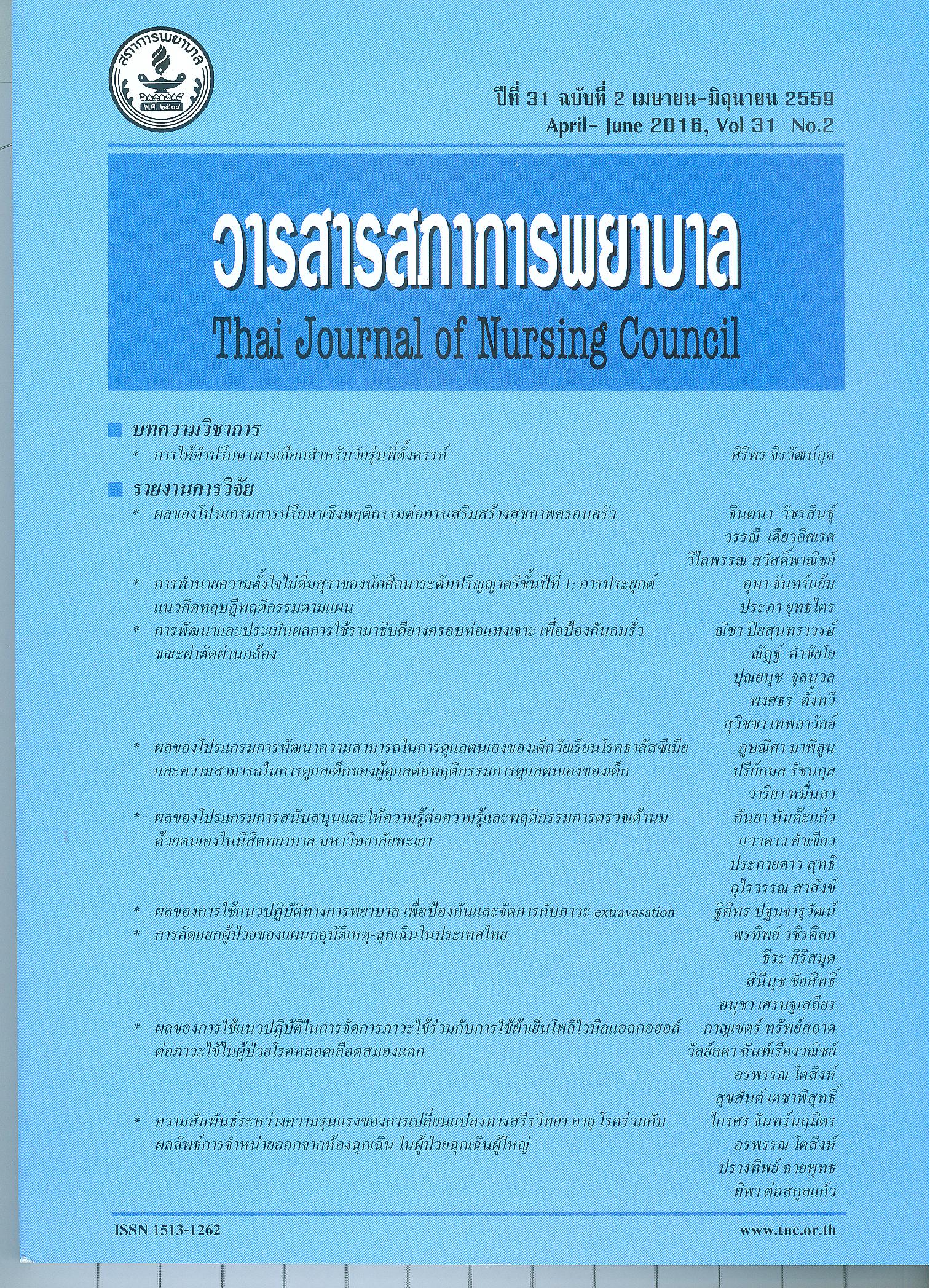ความสัมพันธ์ระหว่างความรุนแรงของการเปลี่ยนแปลงทางสรีรวิทยา อายุ โรคร่วม กับผลลัพธ์การจำหน่ายออกจากห้องฉุกเฉิน ในผู้ป่วยฉุกเฉินผู้ใหญ่
Keywords:
การเปลี่ยนแปลงทางสรีรวิทยา, อายุ, โรคร่วม, ผลลัพธ์การจำหน่ายออกจากห้องฉุกเฉิน, physiological deterioration severity, age, comorbidity, emergency room discharge destinationAbstract
วัตถุประสงค์ของการวิจัย เพื่อศึกษาความสัมพันธ์ระหว่างความรุนแรงของการเปลี่ยนแปลงทางสรีรวิทยา อายุและโรคร่วมกับผลลัพธ์การจำหน่ายออกจากห้องฉุกเฉิน ในผู้ป่วยฉุกเฉินผู้ใหญ่
การออกแบบการวิจัย : การวิจัยแบบบรรยายเชิงหาความสัมพันธ์ (descriptive correlation study)
วิธีดำเนินการวิจัย : ผู้ป่วยที่มารับการรักษาหน่วยงานอุบัติเหตุและฉุกเฉิน ของ โรงพยาบาลจังหวัดแห่งหนึ่งในภาคกลาง จำนวน 197 คน เลือกกลุ่มตัวอย่างตามเกณฑ์คัดเข้าที่กำหนดไว้ เก็บรวบรวมข้อมูลโดยใช้ การจำแนกระดับความรุนแรงของการเปลี่ยนแปลงทางสรีรวิทยา (Modified Early Warning Score : MEWS) แบบบันทึกโรคร่วม และแบบประเมินผลลัพธ์การจำหน่ายออกจากห้องฉุกเฉิน วิเคราะห์ข้อมูลโดยใช้สถิติพรรณนา และการวิเคราะห์ Spearman Rank Correlation
ผลการวิจัย : ผู้ป่วยมีช่วงอายุระหว่าง 18 - 93 ปี อายุเฉลี่ย 49.6 ปี (SD = 20.29 ปี ) ส่วนใหญ่เป็นเพศหญิง (ร้อยละ 58.1) และมีโรคประจำตัว (ร้อยละ 55.1) มารับการรักษาด้วยอาการเจ็บป่วยฉุกเฉินร้อยละ 89.9 และจากการบาดเจ็บ ร้อยละ 13.1 อาการฉุกเฉิน 3 ลำดับแรกคือ อาการฉุกเฉินระบบประสาท (ร้อยละ 23.4) ฉุกเฉินระบบทางเดินอาหาร(ร้อยละ 22.8) และฉุกเฉินระบบหายใจ (ร้อยละ19.8) ผู้ป่วยที่มีค่าคะแนน MEWS แรกรับ ที่อยู่ในระดับรุนแรงปานกลาง ถึงรุนแรงมาก มีจำนวนร้อยละ 19.7 (39 คน) ผลลัพธ์การจำหน่ายจากห้องฉุกเฉิน พบว่า ผู้ป่วย ร้อยละ 26.9 ต้องรับไว้รักษาตัวในโรงพยาบาล ซึ่งในจำนวนนี้ร้อยละ 23.9 รับการรักษาตัวในหอผู้ป่วยสามัญ และ ร้อยละ 3 ต้องรับไว้รักษาตัวในหอผู้ป่วยวิกฤต ความรุนแรงของการเปลี่ยนแปลงทางสรีรวิทยา มีความสัมพันธ์ทางบวกกับผลลัพธ์การจำหน่ายออกจากห้องฉุกเฉินในระดับปานกลาง ( r = .58, p < .05) อายุ และโรคร่วมของผู้ป่วย มีความสัมพันธ์ทางบวกกับกับผลลัพธ์การจำหน่ายออกจากห้องฉุกเฉินในระดับต่ำ ( r = .25, p < .05; r = .29, p < .05 ตามลำดับ)
ข้อเสนอแนะ : พัฒนาระบบการคัดแยกผู้ป่วยที่มารับบริการ ณ ห้องฉุกเฉิน โดยใช้แบบบันทึกการเปลี่ยนแปลงทางสรีรวิทยาร่วมกับข้อมูลด้านอายุและโรคร่วม ทั้งนี้เพื่อการเฝ้าระวังและดูแลอย่างใกล้ชิดโดยเฉพาะในกลุ่มผู้ป่วยที่มีแนวโน้มในการเข้ารับรักษาตัวในโรงพยาบาล
Objective: To identify the correlation between emergency room discharge destination in adult patients and the factors of physiological deterioration severity, age, and comorbidity.
Design: Descriptive correlational study.
Implementation: The study sample consisted of 197 patients in the emergency and trauma unit of a hospital in central Thailand. The subjects were obtained based on pre-set criteria. Data were collected using (1) the Modified Early Warning Score (MEWS); (2) a comorbidity evaluation form; and (3) an emergency room discharge evaluation form. The data were analysed using descriptive statistics and Spearman’s Rank Correlation.
Results: The subjects were aged from 19 to 93 years, with the average age being 49.6 years (SD = 20.29). More than half (58.1%) were female and had congenital disorders (55.1%). Nearly 90% of the subjects (89.9%) were being treated for emergency illnesses and 13.1% for injuries. The top three types of emergency were neurological emergency (23.4%), gastrointestinal emergency (22.8%) and respiratory emergency (19.8%).
Thirty-nine (19.7%) of the subjects showed moderate to severe upon-admittance MEWS conditions. Over one-fourth (26.9%) of the subjects remained hospitalised after being discharged from the emergency room, with 23.9% in general wards and the remaining 3% in the intensive care unit.
A moderate positive correlation was found between the subjects’ physiological deterioration severity and their emergency room discharge (r = .58, p < .05), whereas low positive correlations were found between the subjects’ age (r = .25, p < .05) and comorbidity (r = .29, p < .05) and their emergency room discharge.
Recommendations: It is recommended that a physiological deterioration severity scale, along with age and comorbidity information, be used to improve the emergency room’s patient-screening process, in order to closely monitor patients, particularly those likely in need of hospitalisation
Downloads
References
Garcia TC, Bernstein AB, Bush MA. Emergency department visitors and visits: who used the emergency room in 2007? NCHS data brief. 2010(38):1.
Gindi RM, Cohen RA, Kirzinger WK. Emergency room use among adults aged 18–64: early release of estimates from the National Health Interview Survey, January–June 2011. National Center for Health Statistics. 2012.
Gilboy N, Tanabe T, Travers D, Rosenau AM. Emergency Severity Index (ESI): A triage tool for emergency department. Rockville, MD: Agency for Healthcare Research and Quality Retrieved from http://www ahrq gov/professionals/systems/hospital/esi/esi1 html. 2011.
Subbe C, Kruger M, Rutherford P, Gemmel L. Validation of a modified Early Warning Score in medical admissions. Qjm. 2001;94(10):521-6.
Groarke J, Gallagher J, Stack J, Aftab A, Dwyer C, McGovern R, et al. Use of an admission early warning score to predict patient morbidity and mortality and treatment success. Emer Med J 2008;25:803-6.
Burch V, Tarr G, Morroni C. Modified early warning score predicts the need for hospital admission and inhospital mortality. Emergency Medicine Journal. 2008;25:674-8.
Vicente V, Sjöstrand F, Sundström BW, Svensson L, Castren M. Developing a decision support system for geriatric patients in prehospital care. Eur J Emer Med 2013;20:240-7.
Cousins G, Bennett Z, Dillon G, Smith SM, Galvin R. Adverse outcomes in older adults attending emergency department: systematic review and meta-analysis of the Triage Risk Stratification Tool. Eur J Emer Med 2013.
Polit DF, Beck CT.Essentials of Nursing Research: Appraising Evidence for Nursing Practice.
th Edition; Philadelphia: Lippincott Williams& Wilkins:2013.
Plichta SB, Garzon LS. Statistics for nursing and allied health. Philadelphia: Lippincott Williams & Wilkins; 2009.
Nimmo GR, Lothian N. Adult medical emergencies handbook: NHS Lothian-University Hospitals Division; 2009.
Jones D, Mitchell I, Hillman K, Story D. Defining clinical deterioration. Resuscitation. 2013;84:1029-34.
Smith T, Den Hartog D, Moerman T, Patka P, Van Lieshout E, Schep N. Accuracy of an expanded early warning score for patients in general and trauma surgery wards. Brit J Surg 2012;99:192-7.
Ruiz M, Reske T, Cefalu C, Estrada J. Management of elderly and frail elderly cancer patients: the importance of comprehensive geriatrics assessment and the need for guidelines. A J Med Sci 2013;346(1):66-9.
Cei M, Bartolomei C, Mumoli N. In‐hospital mortality and morbidity of elderly medical patients can be predicted at admission by the Modified Early Warning Score: a prospective study. Int J Clin Prac 2009;63:591-5.
Maccarone N, Guerri I, Franchi M, Fricelli C, Perretta L, Zagli G, et al. Impact of a systematic MEWS introduction on preoperative and postoperative evaluation in urgent/emergency surgery. Crit Care 2010;14(Suppl 1):1-2.
Grossmann FF, Zumbrunn T, Frauchiger A, Delport K, Bingisser R, Nickel CH. At risk of undertriage? Testing the performance and accuracy of the emergency severity index in older emergency department patients. Ann Em M 2012;60:317-25. e3.
Vles WJ, Veen EJ, Roukema JA, Meeuwis JD, Leenen LP. Consequences of delayed diagnoses in trauma patients: a prospective study. J Am Col Surg 2003;197(4):596- 602
McHugh M, VanDyke K, McClelland M, Moss D. Improving patient flow and reducing emergency department crowding: A guide for hospitals. 2012.








